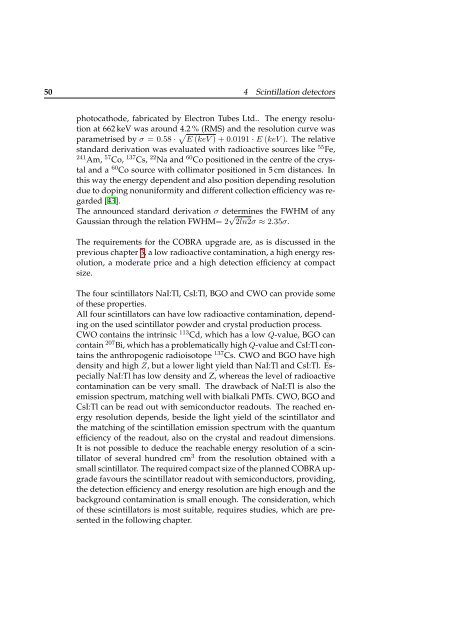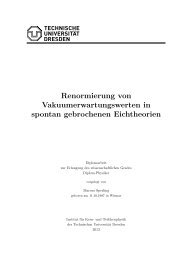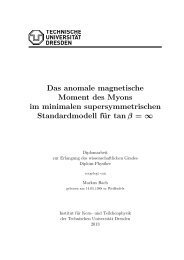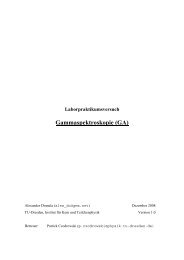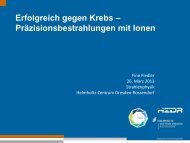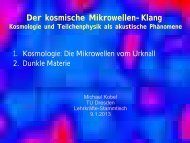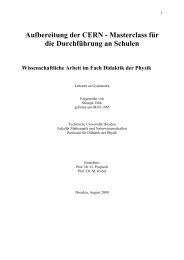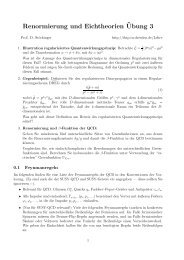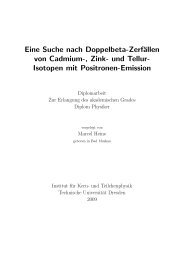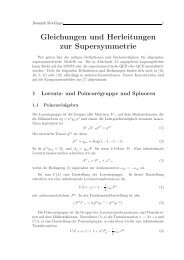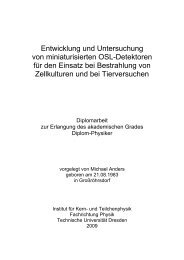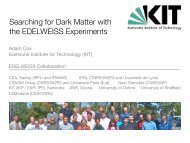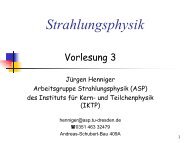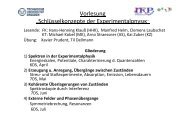a design study for a cobra upgrade to - Institut für Kern- und ...
a design study for a cobra upgrade to - Institut für Kern- und ...
a design study for a cobra upgrade to - Institut für Kern- und ...
You also want an ePaper? Increase the reach of your titles
YUMPU automatically turns print PDFs into web optimized ePapers that Google loves.
50 4 Scintillation detec<strong>to</strong>rs<br />
pho<strong>to</strong>cathode, fabricated by Electron Tubes Ltd.. The energy resolution<br />
at 662 keV was aro<strong>und</strong> 4.2 % (RMS) and the resolution curve was<br />
parametrised by σ = 0.58 · � E (keV ) + 0.0191 · E (keV ). The relative<br />
standard derivation was evaluated with radioactive sources like 55 Fe,<br />
241 Am, 57 Co, 137 Cs, 22 Na and 60 Co positioned in the centre of the crystal<br />
and a 60 Co source with collima<strong>to</strong>r positioned in 5 cm distances. In<br />
this way the energy dependent and also position depending resolution<br />
due <strong>to</strong> doping nonuni<strong>for</strong>mity and different collection efficiency was regarded<br />
[43].<br />
The announced standard derivation σ determines the FWHM of any<br />
Gaussian through the relation FWHM= 2 √ 2ln2σ ≈ 2.35σ.<br />
The requirements <strong>for</strong> the COBRA <strong>upgrade</strong> are, as is discussed in the<br />
previous chapter 3, a low radioactive contamination, a high energy resolution,<br />
a moderate price and a high detection efficiency at compact<br />
size.<br />
The four scintilla<strong>to</strong>rs NaI:Tl, CsI:Tl, BGO and CWO can provide some<br />
of these properties.<br />
All four scintilla<strong>to</strong>rs can have low radioactive contamination, depending<br />
on the used scintilla<strong>to</strong>r powder and crystal production process.<br />
CWO contains the intrinsic 113 Cd, which has a low Q-value, BGO can<br />
contain 207 Bi, which has a problematically high Q-value and CsI:Tl contains<br />
the anthropogenic radioiso<strong>to</strong>pe 137 Cs. CWO and BGO have high<br />
density and high Z, but a lower light yield than NaI:Tl and CsI:Tl. Especially<br />
NaI:Tl has low density and Z, whereas the level of radioactive<br />
contamination can be very small. The drawback of NaI:Tl is also the<br />
emission spectrum, matching well with bialkali PMTs. CWO, BGO and<br />
CsI:Tl can be read out with semiconduc<strong>to</strong>r readouts. The reached energy<br />
resolution depends, beside the light yield of the scintilla<strong>to</strong>r and<br />
the matching of the scintillation emission spectrum with the quantum<br />
efficiency of the readout, also on the crystal and readout dimensions.<br />
It is not possible <strong>to</strong> deduce the reachable energy resolution of a scintilla<strong>to</strong>r<br />
of several h<strong>und</strong>red cm 3 from the resolution obtained with a<br />
small scintilla<strong>to</strong>r. The required compact size of the planned COBRA <strong>upgrade</strong><br />
favours the scintilla<strong>to</strong>r readout with semiconduc<strong>to</strong>rs, providing,<br />
the detection efficiency and energy resolution are high enough and the<br />
backgro<strong>und</strong> contamination is small enough. The consideration, which<br />
of these scintilla<strong>to</strong>rs is most suitable, requires studies, which are presented<br />
in the following chapter.


